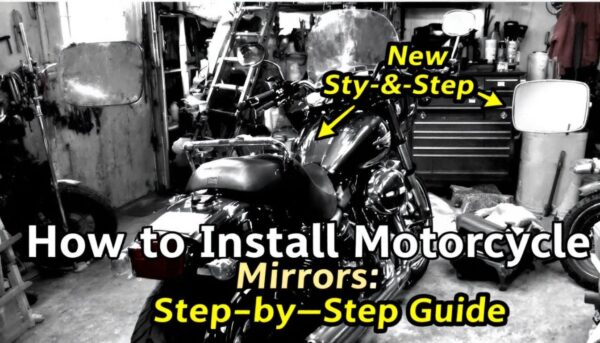
Motorcycle Battery Types: Which One is Right for Your Bike?
Choosing the right motorcycle battery can be tricky. You want your bike to start every time and have enough power for all its needs. There’s a lot to know about motorbike battery types, including wet cell, dry cell (AGM), and gel cell options.
Each type has its own benefits and downsides.
This article will help you pick the best motorbike battery for your ride. We’ll cover different motorcycle battery options, how to select the right one for your bike, and tips on keeping it in top shape.
Ready to find out which battery is perfect for you? Keep reading!
Key Takeaways
- Different motorcycle batteries include wet cell, dry cell (AGM), gel cell, and lithium iron phosphate (LiFePO4). Each has pros and cons.
- When choosing a battery, think about your bike’s age and model, how you ride, and the weather. Pick a battery that fits these needs.
- Good care extends your battery’s life. For lead-acid batteries, check water levels often. Use a smart charger for all types to avoid damage.
- AGM batteries don’t need water added and are spill-proof. They last longer but cost more than wet cell batteries.
- It’s important to buy from trusted brands for quality assurance. Always keep the manual handy for specific battery requirements of your bike.
Overview of Different Types of Motorcycle Batteries
Motorcycle batteries come in different types. Each type has its own features and uses.
Wet Cell or Lead Acid Batteries
Wet cell or lead acid batteries are common in motorcycles. These batteries use a liquid electrolyte to store energy. They are known for their reliability and low cost. Many bikers choose them because they have been around for a long time.
These batteries come in two main types: starter and deep cycle. Starter wet cell batteries provide quick bursts of power to start your engine. Deep cycle batteries are meant for longer usage like powering accessories on your bike.
Wet cell batteries need regular maintenance, such as checking the water levels, to ensure they work well.
Although these lead acid batteries weigh more than others, they perform well under various conditions. You should consider size and capacity when selecting one for your motorcycle battery needs.
Knowing how each battery works will help you make an informed choice about which type is best suited for you.
Next up is dry cell or AGM batteries, another popular option among motorbike enthusiasts.
Dry Cell or AGM Batteries
Dry cell or AGM batteries are a popular choice for motorcycles. They are also known as absorbed glass mat batteries. These batteries use a special design that absorbs the electrolyte in glass mats.
This makes them spill-proof and safer to use.
AGM batteries have many benefits. They charge faster than traditional lead acid batteries. Their lifespan is longer too, often lasting up to five years or more with proper care. Regular maintenance is easier because they don’t need water added like wet cell batteries do.
Consider your bike’s needs when choosing an AGM battery. Ensure it fits well and meets your motorcycle’s specifications. Check the size chart for 12V motorcycle battery sizes to find the right fit for your bike type and model before buying one of these reliable options.
Gel Cell Powersports Batteries
Gel cell powersports batteries are a type of sealed lead-acid battery. They use a gel electrolyte instead of liquid. This design makes them safer and less likely to spill. They provide solid power for your motorbike while being maintenance-free.
These batteries work well in various environments, including extreme weather conditions. Gel cell batteries also last longer than some other types. You can trust their reliability on the road.
Consider choosing a gel cell if you want an option that is easy to manage and dependable for your bike’s needs.
Next, let’s look at the pros and cons of each type of motorcycle battery.
Pros and Cons of Each Type of Motorcycle Battery
Choosing the right motorcycle battery involves weighing up the benefits and drawbacks of each type. Here’s a straightforward comparison to help you decide.
| Type of Battery | Pros | Cons |
|---|---|---|
| Wet Cell or Lead Acid Batteries | Cheaper, tried and tested technology. | Needs regular maintenance, can spill acid if tipped. |
| Dry Cell or AGM Batteries | Doesn’t need topping up, more resistant to vibration. | More expensive than wet cell, can be heavier. |
| Gel Cell Powersports Batteries | Leak-proof, works well in extreme temperatures. | Costlier, sensitive to overcharging. |
| Lithium Iron Phosphate (LiFePO4) Batteries | Lightweight, long lifespan, high performance. | Most expensive, needs compatible charger. |
Each battery type suits different bikes and rider needs. Consider what’s best for your motorcycle and riding style.
Selecting the Right Motorcycle Battery for Your Bike
4. Selecting the Right Motorcycle Battery for Your Bike: Choose a battery that fits your bike’s age and model. Think about how you ride and where you go. Pick brands that are well-known for quality.
Take care of your battery to keep it running smoothly. For more details, check out the rest of our guide!
Consider the age and model of your bike
The age and model of your bike play a big role in choosing the right motorcycle battery. Older bikes often use traditional lead acid or AGM batteries. These batteries are reliable and have been used for many years.
If you own a new bike, it might be designed for lithium-ion or lithium iron phosphate (LiFePO4) batteries. These newer options can offer better performance.
Check your bike’s manual for its specific battery size and type. Each model has unique needs that affect battery selection. Using the right motorbike battery ensures it fits well and works properly.
It helps improve overall performance too.
Looking at the model’s features also matters in making a choice between different motorcycle battery types like gel cell or maintenance-free options. Consider all these factors carefully before selecting the best motorbike battery for your ride.
Determine your riding needs and environment
Selecting the right battery for your motorcycle depends on your riding needs and environment. Different types of batteries can handle various conditions. If you ride in extreme weather, consider a stronger battery like lithium or AGM.
These batteries often perform better in cold or hot climates.
Your riding style also matters. Short rides may work with a standard wet cell battery, but if you travel long distances, a gel cell motorbike battery is ideal as it lasts longer. Factor in how often you charge your bike too.
Understanding these details will help you find the best type of battery for motorcycles that fits your lifestyle and bike’s requirements.
Look for reputable brands
Choose a battery from reputable brands. These brands likely offer reliable products and good customer support. Popular options include traditional lead-acid batteries and AGM batteries.
Check for Lithium Iron Phosphate (LiFePO4) batteries as well.
Reading reviews helps you make the best choice. Look for feedback from other riders about their experiences with a particular brand or model. Focus on companies known for quality motorcycle batteries, especially those that fit your bike’s needs.
A trusted brand will give you peace of mind that you’re selecting the right battery for your motorcycle.
Properly maintain and care for your battery
Proper maintenance is key for your motorcycle battery. Each type of battery has specific care needs. For lead-acid batteries, check the water levels often. Add distilled water if it gets low.
AGM and gel cell batteries need less upkeep but still require routine checks.
Charging your battery is also important. Use a smart charger to avoid overcharging or undercharging. This will help extend the life of your battery. Regularly clean the terminals too, as dirt and corrosion can cause issues.
Consider the age of your bike and its riding conditions when maintaining your battery. Hot weather can drain power faster than cold weather, especially for lithium-ion types. Always pick a reputable brand to ensure reliability in tough conditions while choosing a motorbike battery suitable for you.
Conclusion
Choosing the right motorcycle battery is key for your bike. Consider its type and size carefully. Each type has strengths and weaknesses. Think about how you ride and where you ride.
A little research can help you find the best fit for your needs.
FAQs
1. What types of batteries are there for motorcycles?
There are several motorcycle battery types, including lithium motorbike batteries and maintenance-free motorbike batteries.
2. How do I choose the right battery for my bike?
Choosing a battery for your bike involves considering factors like size, power requirements, and the type of your vehicle. A motorcycle battery comparison can be helpful in this process.
3. Are all motorbike battery sizes the same?
No, motorbike battery sizes vary depending on the make and model of your bike. It’s important to check what size is suitable for your specific vehicle.
4. Which is considered as the best type of battery for a motorbike in Australia?
While it depends on individual needs and preferences, many riders find that a lithium motorbike battery is one of the best choices because it’s lightweight and requires less charging.
5. Any tips about maintaining my motorcycle’s battery?
Yes! Regularly checking if it holds charge properly and keeping terminals clean are just some of the basic motorcycle maintenance tips to ensure long-lasting performance.


